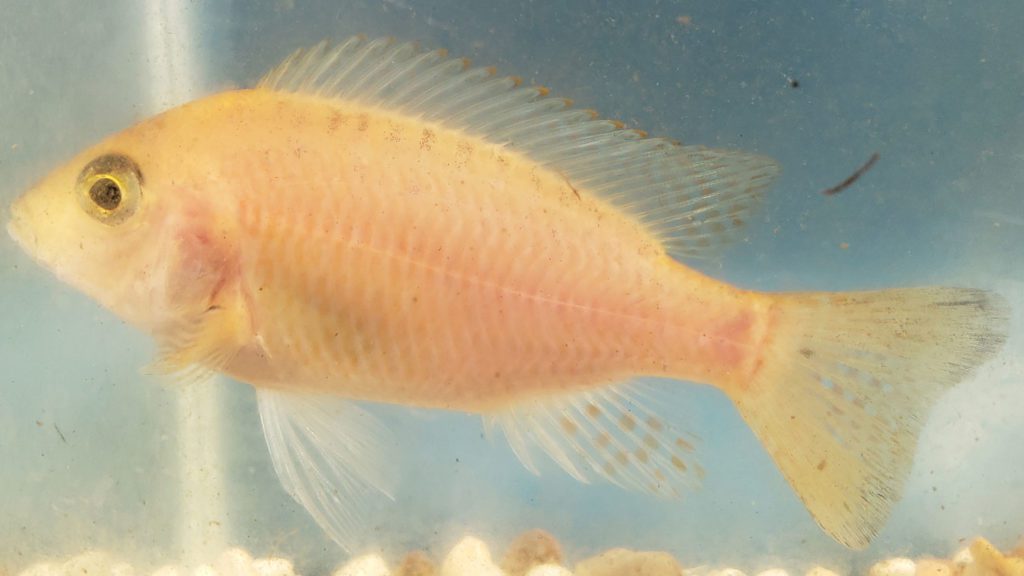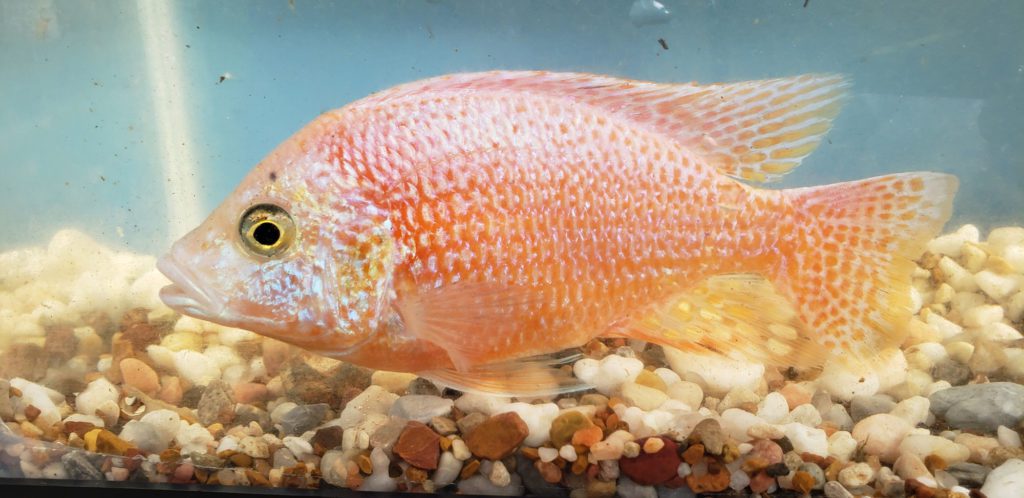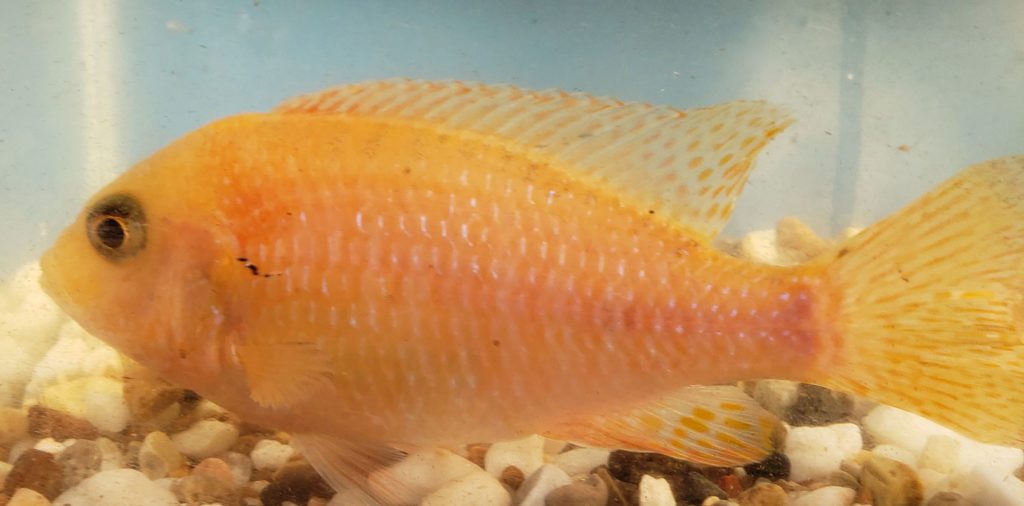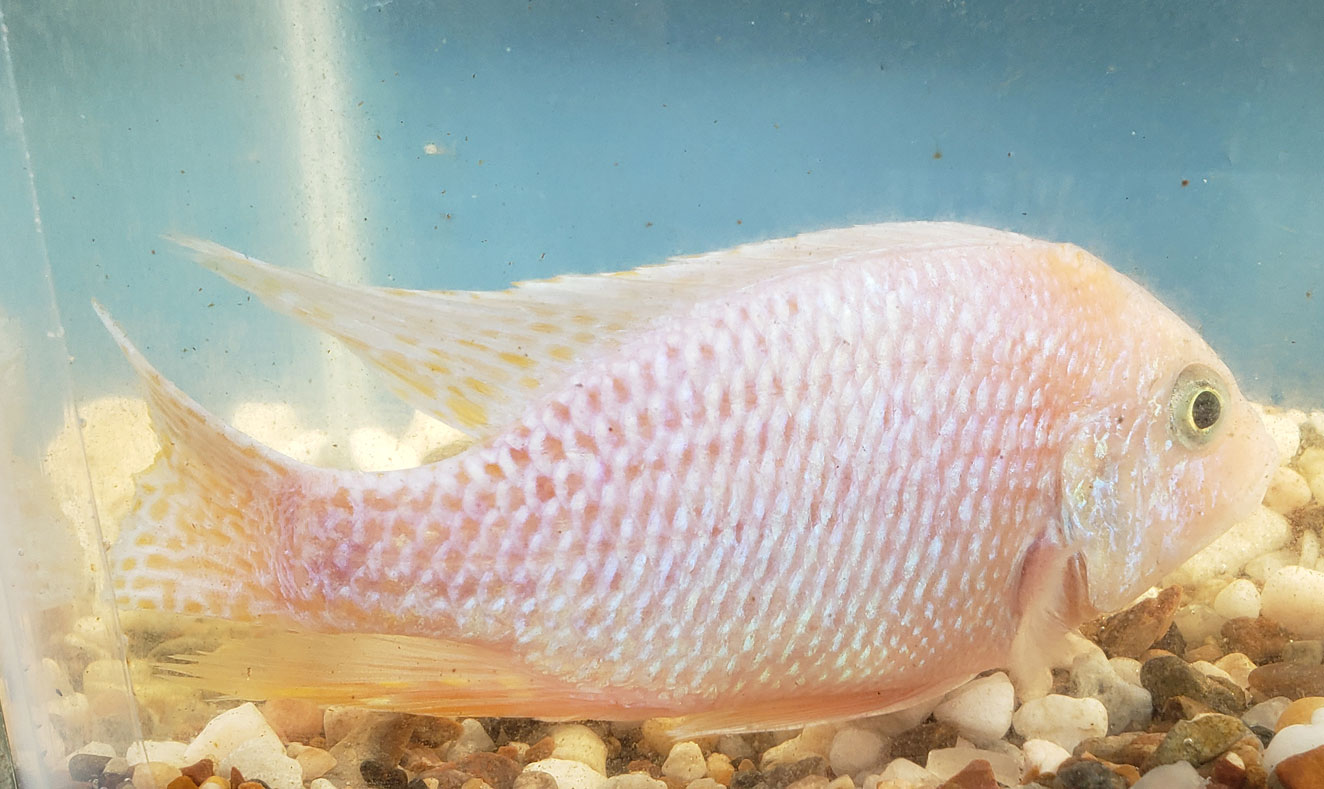Photo: A young breeder male Skyblue Dragon Blood Peacock Cichlid.
One of my favorite aquaculture activities is the development of new strains of fish with new colors, fins, shapes, etc. That isn’t to say that I don’t enjoy maintaining wild-type fish and pure species as they appear in nature, but there is something satisfying about imagining and then creating new strains. Over the years, I’ve developed procedures and processes to make this easier and more predictable. For this blog, I’ll use our Skyblue Dragon Blood Peacock Cichlids as an example.
For some additional background on our Dragon Blood Peacocks see these blogs:
https://goliadfarms.com/dragon-blood-peacock/
https://goliadfarms.com/dragon-blood-peacock-cichlid/
https://goliadfarms.com/dragon-blood-peacock-cichlid-genetics/
https://goliadfarms.com/non-gold-dragon-blood-peacock/
Our breeding records show that we isolated some prototype Skyblue Dragon Bloods from our Dragon Blood Peacocks, which we now call Red Dragon Bloods, in March 2014. By the way, we are also working on Orange Dragon Bloods and Gold Dragon Bloods, both also isolated from the Red Dragon Bloods.
Unfortunately, many of our breeding programs, including the Skyblue Dragon Bloods, got a huge setback with Hurricane Harvey in August 2017. For some information about the impact of Harvey, see these blogs:
https://goliadfarms.com/hurricane-harvey-recovery-september-12th/
https://goliadfarms.com/teas-fish-and-chickens/
https://goliadfarms.com/drought-and-flood/
Three years after Harvey we are finally getting our operations back on an even keel and are only running a handful of months behind on processing our breeders, including the Skyblue Dragon Bloods. They should have been processed in July and we finally did them in September. As a result, we lost some production of fry as the older brethren of newer fry ate them. Nevertheless, we are making progress.
So, let me describe how we go about developing new strains, using the Skyblue Dragon Bloods as an example. Often the first step occurs when we process a group of fish and I notice an unusual fish, usually male since they are typically more colorful than females, especially among the Peacock Cichlids. In the case of Skyblue Dragon Bloods, while processing Red Dragon Bloods in 2014, I found a couple of males that reminded me of our Skyblue OB Peacocks (see: https://goliadfarms.com/skyblue-ob-peacock-cichlid/) but with the gold body and iridescence of Dragon Bloods. I put them temporarily aside in a 5-gallon bucket and told Susie (wife and tyrannical business manager who is controlled solely by the financial bottom line) that I wanted to devote a vat to them. After an eye-roll reminiscent of the best from our granddaughters, she reluctantly agreed to devoting some precious real estate to yet another of my “experimentals,” a term she derisively uses to describe any fish that doesn’t immediately yield a profit. I selected some related Dragon Blood females and set them up for breeding. Skyblue Dragon Bloods, at least in concept, were born.
The Dragon Blood females I selected were pale gold with no hints of red. Why? Because my prior experience with Skyblue OB Peacocks showed pale females produced the best Skyblue OB sons. I hoped the same would happen with this strain.
Since that time, we’ve only gone through four generations of selection. Typically, we would have done twice that, but Harvey and its aftermath prevented normal operations.
When working on a new strain, I rear the first offspring to breeding size and compare them to the original breeders. Most often that first set of offspring doesn’t match up to the original breeders. That happened in this case. None of the sons were as Skyblue Dragon Blood as the two original males. The sons weren’t bad fish, they just weren’t what I imagined Skyblue Dragon Bloods to be. They were sold off. This demonstrates one technique I use: keep the original breeder male(s) until one or more better male appears.
Next, I replaced all the original breeder females with young female offspring from the original breeders. As before, I selected pale females with no hints of red. Why discard the original females? Because they didn’t produce any sons that were better than the two breeder males. If they had, I might have kept them to breed them back to any better sons. Since they didn’t produce better sons, I replaced them with daughters of the two breeder males. Why? Because these daughters would be carrying genes that made their fathers the best Skyblue Dragon Bloods I had. This demonstrates another technique: upgrade breeders when the new ones might carry the characteristics you are selecting for.
Let’s digress here. I’m sure you noted that in any event I would have been inbreeding to produce the next generation. Inbreeding gets a lot of bad press, but it is your most powerful tool when improving a strain. Without inbreeding none of our livestock breeds and pet breeds would exist. Our crop yields would be paltry and hardly worth the effort of growing without inbreeding. Inbreeding does two things, 1) it allows you to purge bad characteristics and 2) it reduces variability and concentrates good characteristics.
How does inbreeding let you purge bad characteristics? It exposes those breeders carrying recessive deleterious genes. Here’s an example from our hatchery. Long ago we got a small group of Ameca splendens, a livebearing fish from Mexico. In that small group was at least one fish with a recessive gene causing a bent spine between the dorsal fin and the caudal fin. To eliminate the gene, I could have set up test crosses. Each potential breeder (meaning not bent) could have been mated to fish with bent spines. If all the offspring were non-bent, then the breeder could be retained. Of course, all those offspring would have to culled since they carried the deleterious recessive. But that procedure isn’t practical in our operations and it deliberately produces bad fish, so I chose another way of purging the gene. Every generation I replaced all the breeders with their offspring. All the bent spine fish were purged. Within a few generations the gene was eliminated. For those who took college genetics and are familiar with Harding-Weinberg equilibrium equations, you can run the equations through a few generations and see why that worked. Maybe someday, if there is demand for it, I’ll do a blog featuring and demonstrating Harding-Weinberg equations.
What about concentrating desirable characteristics? Inbreeding, combined with rigorous selection, reduces variation by retaining the characteristics you want and purging those you don’t. Hardy-Weinberg equations are useful for showing why this is true, but you don’t have to be a geneticist to see why this is so. If you continually select the best breeders each generation, the percentage of offspring that are desirable will increase.
But what about inbreeding depression? In my experience this doesn’t happen. One prime example of how this isn’t significant is the 140+ generations of brother-sister matings of Xiphophorus maculatus at the Xiphophorus Genetic Stock Center at Texas State University. Long ago, Dr. Myron Gordon started this inbreeding project. Today the resulting fish are perfectly healthy and normal despite the 140+ generations of the most intense inbreeding one can do. Our hatchery has other examples, primary with our award-winning mollies. We inbreed to produce some of the largest and healthiest mollies you can see and have many first place awards at American Livebearer Association (https://livebearers.org/) annual shows to prove that. (As a quick aside here: Hurricane Harvey and its aftermath decimated our mollies. We are rebuilding our stocks and hope to return them to their previous splendor.)
Digression over.
Back to the Skyblue Dragon Bloods. We saw improvement in the offspring once we’d mated our original males to their daughters and began the next step in improvement. Any young male what was better than a breeder replaced that breeder. We continued replacing female breeders with daughters of the current breeders, these daughters were also granddaughters of the two original breeder males.
This process was interrupted by Hurricane Harvey, but is now continuing. Our new breeding colony consists of one retained breeder male (not one of the original males, but one of their offspring) and two new breeder males, descendants of the last group of breeders. Fifteen breeder females were kept, and the rest purged due to being not pale enough or having developed red highlights. Twenty-six new female breeders were selected to replace purged females. This process will continue each breeding cycle until the strain breeds completely true, producing the Skyblue Dragon Bloods I first imagined when seeing the two original males.
Below are photos of a new breeder male and breeder female. Below that are photos of a purged male and female.
This is the same photo from the beginning of the blog. He is a young male Skyblue Dragon Blood Peacock just added to the breeding colony.

This photo of a young female Skyblue Dragon Blood Peacock who, along with 25 closely related young females, was just added to the breeding colony.

This is a photo of a young male just purged from the Skyblue Dragon Blood strain because he’s going to be a nice Red Dragon Blood. Fish like this will become fewer and fewer in subsequent generations of the Skyblue Dragon Blood strain.

This is a photo of one of the breeding female Skyblue Dragon Blood Peacocks removed from the breeding colony because she shows too much red and is not pale enough. Her body color is too red-orange. She might make a good Red Dragon Blood breeder. Compare her to the paler female above.

Let’s recap the process, assuming you start with a male since they are typically more colorful and have gaudier finnage:
- Pick a male that most resembles what you imagine.
- Mate that male to close relatives, preferably siblings.
- Rear their offspring to maturity and compare them to your breeder.
- If your breeder is better than any of his offspring, select his daughters to mate to him.
- If an offspring is better, replace your breeder with it and mate him to selected sisters.
- Continue this process by repeating steps 3. through 5.
- Once you have achieved what you imagined, continue to inbreed to set the strain and then maintain it.
This works well with female mouthbrooding, non-pair bonding cichlids. With pair bonding cichlids the process is the same except you are selecting a single female. With Poeciliidae livebearers (swordtails, mollies, guppies, and the like) things are complicated by female sperm storage making male parentage of the offspring iffy if the females were ever exposed to any other males.
Good fishkeeping!


Leave a Reply